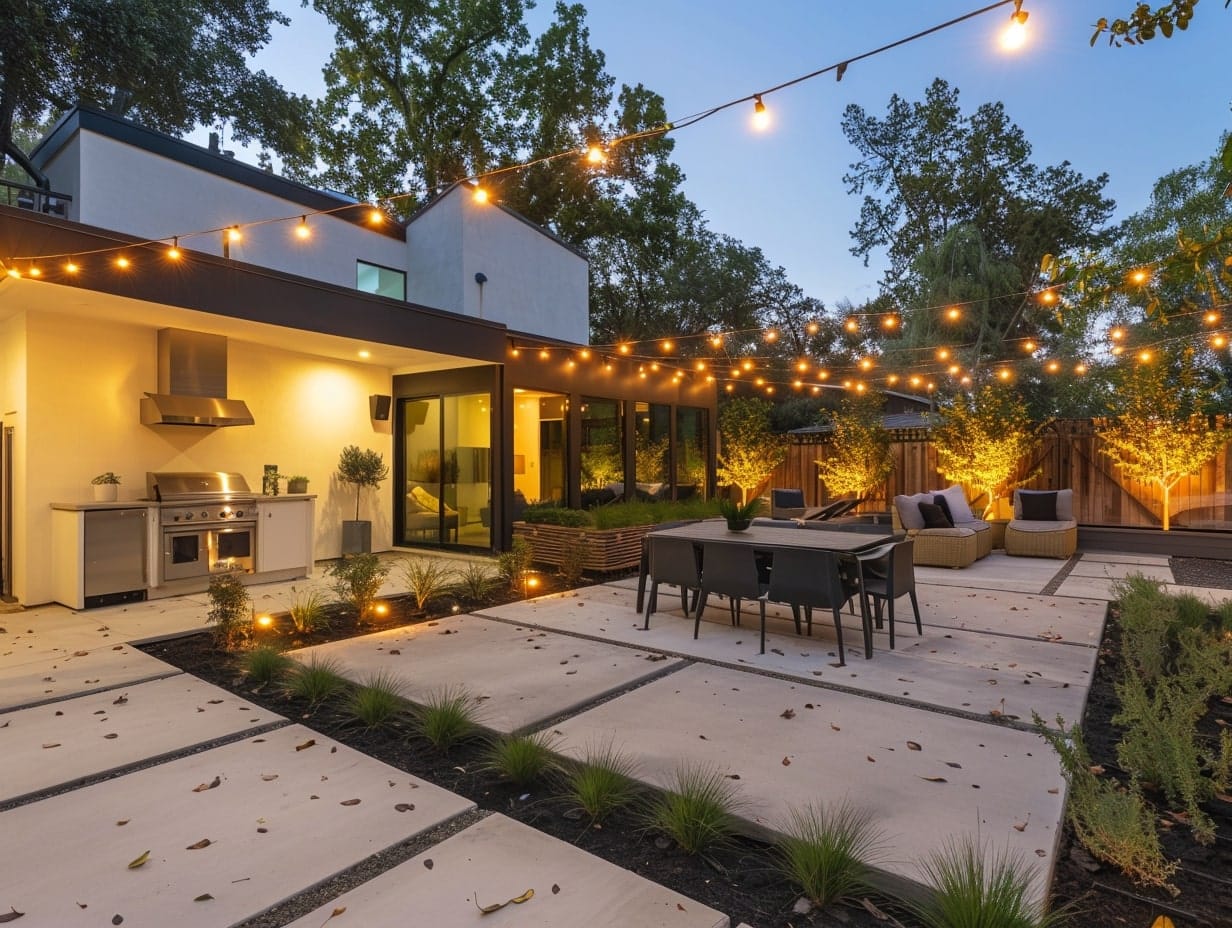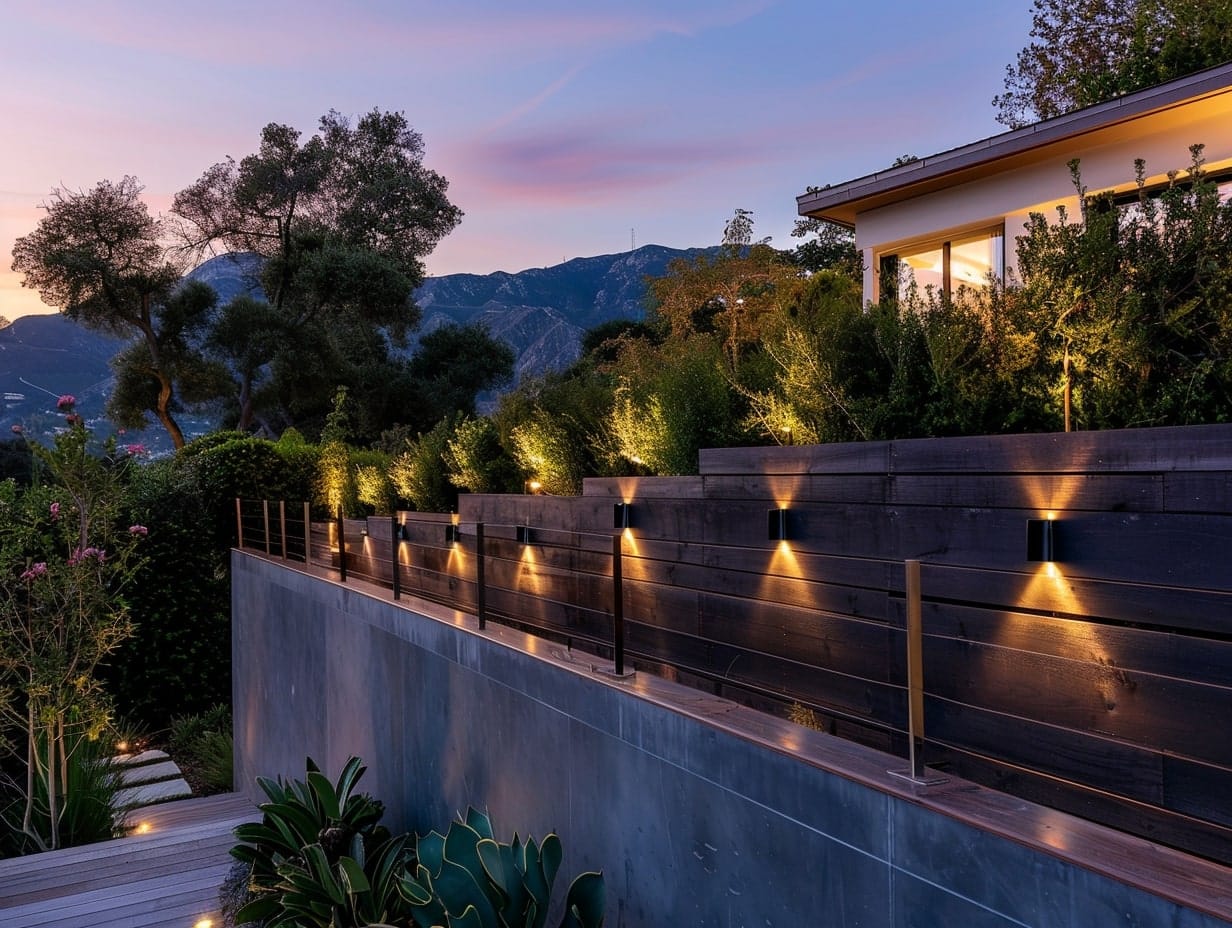When you buy products via links on our website, we might receive an affiliate commission. Learn more
9 Biggest Outdoor Lighting Mistakes

In this insightful blog post on the biggest outdoor lighting mistakes, we cover the 9 biggest outdoor lighting mistakes homeowners often make and provide tips for optimum illumination.
Learn how to balance your outdoor lighting setup between too little or too much light, enhancing the aesthetics, ambience and safety of your yard. Explore the benefits of LED lighting, the importance of layered lighting and how to ensure a consistent lighting design. We also discuss practical considerations, such as safe DIY installation, environment factors and advantages of smart lighting.
Avoid these pitfalls to elevate your outdoor space’s functionality, security and visual appeal.
Not Enough or Excessive Lighting

Balanced outdoor lighting is critical to creating an aesthetically appealing and functional outdoor space.
Insufficient lighting can leave your yard dark and unwelcoming, making it a perfect target for burglars and potential intruders. It can also reduce your property’s value. Latest findings show that outdoor lighting can increase a home's curb appeal, potentially boosting property value by up to 20%.
Underlit areas can make nighttime navigation challenging and unsafe, especially in areas with obstacles, steps, and uneven surfaces.
On the other hand, excessive lighting can diminish your yard’s ambience and create glare and waste energy.
Overly bright lights can be visually overwhelming, especially for older individuals with eyes sensitive to light. They can also lead to energy wastage, resulting in higher utility bills and environmental impact.
Tips to Find the Right Balance
- Consider the purpose of each area when planning lighting. For example, outdoor seating areas can benefit from softer and more ambient light sources, whereas pathways require consistent and clearer lighting.
- Choose the right intensity and placement of lights to enhance your yard’s aesthetics and ambience, without overwhelming it.
- Use a mix of light sources, such as lanterns, pathway lights, spotlights, wall sconces, etc., to avoid over-illumination and ensure proper distribution of lights.
- Implement light controls, such as dimmers, motion sensors, and timers to adjust lighting levels automatically based on activity or time of day.
- Consult with a landscape architect or lighting professional for valuable advice on creating a balanced lighting plan.
Explore types of outdoor lighting fixtures for landscaping.
Overlooking LED Lights

Many homeowners overlook LED lighting options due to misconceptions about brightness, cost and quality.
LEDs consume significantly less power than incandescent or halogen bulbs, resulting in reduced environmental impact and lower energy bills.
Beat Common Misconceptions About LED Lights
- Brightness and Color Temperature: Some homeowners believe LEDs produce harsh light or are too bright. However, LEDs are available in a range of brightness levels and color temperatures. You can choose the brightness level and color temperature per your oseuprequirements.
- Cost: Even though LEDs have a higher upfront cost, their long-term savings on energy bills and replacement costs justify the initial investment.
- Limited Application: Many homeowners believe LED lights are not suitable for outdoor applications. However, that’s not true. You can find LED lights for a variety of applications and settings, such as decorative fixtures, landscape lights, security lights, etc. Some LED lights also come with integrated smart technology, allowing for integration with home automation systems, programmability and remote control.
Ignoring the Layered Lighting Approach

Layered lighting is a strategic outdoor lighting approach that combines different lighting styles (ambient, accent, and task lighting) to create a balanced and functional outdoor space. Ignoring this concept can lead to flat and unwelcoming outdoor areas.
Ambient lighting provides overall illumination to the yard, setting the baseline light level (e.g., lamp post lights, wall sconces, etc.). Task lighting focuses on specific areas for specific activities, including outdoor cooking areas, dining areas, reading spots, and so on.
Accent lighting highlights architectural features, such as shrubs, plants, sculptures, and so on. Direction lights and spotlights are typically used for accent lighting.
Therefore, understand and implement the layered lighting approach to improve the aesthetics, ambience and functionality of your yard.
Tips to Implement the Layered Lighting Approach
- Avoid over-reliance on one layer of lighting. For example, relying solely on task lighting can leave your yard underlit, while over-reliance on ambient lighting can lead to light pollution.
- Identify different functions your outdoor spaces serve and plan your lighting accordingly.
Neglecting Your Yard’s Safety and Security

Outdoor lighting also plays a crucial role in boosting the safety and security of your home, guests, and residents. Therefore, neglecting these aspects can lower the value of your property, and leave it vulnerable to potential intruders and accident risks.
Well-lit exteriors are less appealing to burglars and trespassers. Increased visibility raises their chances of being spotted.
Tips to Implement Effective Safety and Security Lighting
- Ensure all entry points in your yard, including doors, gates, and windows are properly illuminated to prevent unauthorized access.
- Illuminate ramps, steps, pathways, and walkways to prevent falling and tripping accidents.
- Ensure proper lighting is areas such as decks, patios, and pools to make these spaces safer for nighttime use.
- Install lights to highlight potential hazards, such as changes in terrain, low walls, and water features.
- Use shielded fixtures to direct light downward and prevent light pollution.
- Leverage the layered lighting approach to enhance the visibility of your yard, while maintaining its aesthetic appeal.
Using Inconsistent Lighting Designs and Styles

Random usage of different lighting styles can lead to aesthetic disruption and confusion, impacting the overall look of your yard.
A consistent lighting style complements the architectural features and landscaping, enhancing your property’s aesthetics and ambience.
Tips to Choose a Consistent Lighting Design or Style for Your Yard
- Ensure the lighting complements the architectural style of your home. For example, traditional or gothic-style lanterns can blend perfectly with the vintage theme of classic homes.
- Consider the landscaping features too. Ensure the fixtures complement your garden’s design and style.
- Build cohesion with indoor lighting. Even though both indoor and outdoor lighting are different, you can still ensure they are part of the same overall design scheme for your house.
- Choose lighting fixtures with similar design elements, finishes and materials to achieve consistency.
- Use bulbs with the same color temperature across all outdoor lighting fixtures to maintain consistent color and lighting quality.
Forgetting About Environment and Weather

You must choose and install outdoor lighting fixtures considering your environment and the local weather. Ignoring these factors can result in malfunctioning, maintenance issues, and safety hazards.
For example, in coastal areas, moisture and salt can lead to corrosion of the lighting fixtures, resulting in degradation and rusting. Similarly, extreme cold or heat can impact the durability and functionality of outdoor lights. Strong winds can cause alignment issues with fixtures or damage their fragile components.
The right fixtures can withstand local weather conditions, ensuring their longevity and performance.
Tips to Choose Environment- and Weather-Friendly Outdoor Lights
- Choose lighting fixtures made from durable and anti-corrosive materials. Copper, stainless steels, and certain treated materials are resistant to corrosion.
- Ensure your lighting fixtures have an appropriate Ingress Protection (IP) rating for your location. The IP rating indicates a fixture’s protection level against dust and water ingress.
- Select designs that protect bulbs and electrical components from physical damage and water seepage.
- Pick lighting solutions that reduce disruption to local wildlife. For example, in coastal areas, turtle-friendly lighting can prevent the disorientation of hatchlings.
- Choose lighting fixtures that reduce light pollution, focusing light downward than allowing it to scatter sideways or upward.
Poor Installation and Placement

Proper installation and placement of your outdoor lighting fixtures are crucial to ensure their effectiveness.
Incorrect placement of lights can lead to inadequate illumination, glare, unattractive lighting effects, and uneven lighting.
Installation mistakes, such as incorrect wiring and improper mounting, can lead to reduced efficiency and safety risks.
Tips for Safe DIY Installation and Proper Placement of Outdoor Lights
- Ensure alignment between the placement of the lighting fixtures and their intended purposes, whether it’s boosting security, highlighting architectural features, etc.
- Perform trial and error to determine the best placement for the lighting fixtures. Install the fixtures temporarily in desired locations at night to assess their effectiveness (this is applicable to battery- and solar-powered outdoor lights).
- Follow the manufacturers’ instructions during installation.
- Use top-quality cables, connectors, and fixtures to ensure safety and reduce accidents during and after installation.
- Ensure all lighting fixtures are outdoor-rated.
- Ensure all outdoor electrical connections are properly secured and sealed against moisture and protected from weather elements.
- Choose lighting fixtures that allow adjustments in angles and directions to optimize the lighting per your requirements.
Neglecting Regular Maintenance

Regular maintenance is critical to ensure the aesthetic appeal, efficiency and longevity of outdoor lighting fixtures. Therefore, neglecting it can lead to a variety of issues, such as increased energy consumption, lower light output, and malfunctioning.
Over time, outdoor lights can become dim due to bulb degradation or dirty lenses, reducing their effectiveness. Neglecting maintenance can also lead to higher energy costs and the need for more frequent repairs.
Tips for Effective Maintenance of Outdoor Lights
- Develop a routine maintenance plan for your outdoor lighting system. Ensure you check the light’s at least twice every year.
- Address issues as soon as you identify them to prevent them from escalating into more severe problems.
- Clean bulbs, lenses, and light fixtures regularly to remove debris and dirt.
- Ensure all electrical connections are secure and corrosion-free, especially in the case of underground wiring.
- Create a log of all maintenance activities, including bulbs changes and repairs, to track the effort, time and cost investment in maintaining your outdoor lighting fixtures.
- Consider working with a professional for annual checkups, especially for complex outdoor lighting arrangements.
- Use LED bulbs wherever possible as they require less maintenance than traditional bulbs.
Undermining the Benefits of Smart Outdoor Lighting

Smart outdoor lighting has evolved over the years and revolutionized how we control and interact with our outdoor lighting fixtures and arrangements.
Therefore, ignoring these advancements can result in missed opportunities for better convenience, enhanced security, and improved energy efficiency.
With smart outdoor lighting systems, you can control outdoor lights with your smartphone or tablet. You can also customize the lighting effects and setups per your requirements.
Even though the initial investment can be higher for smart outdoor lighting, long-term energy savings and enhanced features typically justify the investment.
Tips to Implement Smart Outdoor Lighting Systems
- Assess and evaluate your existing outdoor lighting setup thoroughly to identify opportunities for upgrades to smart lighting solutions.
- Explore how smart outdoor lighting systems can integrate with other home security systems for a unified home automation experience.
- Begin with a small area, then scale up the smart outdoor lighting project gradually.
